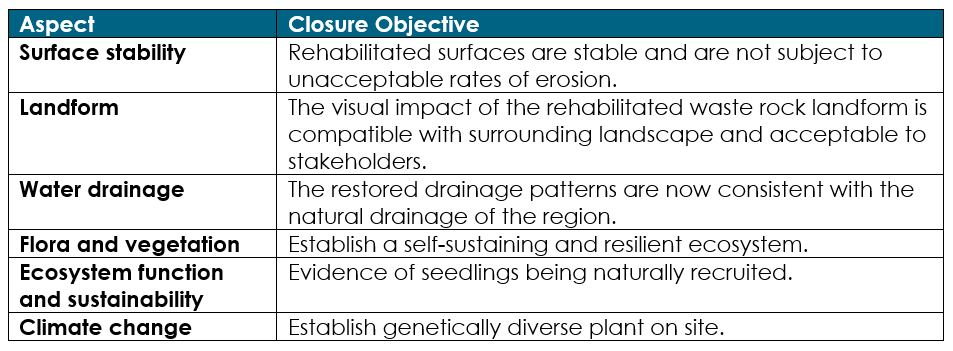- August 30, 2023

Applying the WABSI’s Ecological Completion Criteria Framework
Ecological completion criteria serve as essential benchmarks that guide and define the success of rehabilitation efforts at mine sites, ensuring that the post-closure ecosystem is site-specific and practically achievable. Establishing customized and well-defined ecological completion criteria reinforces responsible mining practices and demonstrates a commitment to long-term environmental stewardship.
Developing ecological completion criteria is a comprehensive and iterative process encompassing ecological, social, economic, and regulatory aspects (Young et al., 2019). However, for clarity, in this article, we explore and present the contribution of the Western Australian Biodiversity Science Institute’s (WABSI) mine site completion criteria framework as a linear process.
While the WABSI ecological completion criteria framework was primarily developed for Western Australian regions, it is worth noting that Okane has demonstrated its effectiveness by applying the framework to foster responsible rehabilitation efforts across a wide range of landscapes in Western Australia and Tasmania in Australia, and New Zealand. This highlights the adaptability of the WABSI ecological completion criteria and suggests the potential applications in various ecosystems.
WABSI’s Ecological Completion Criteria Framework
The ecological completion criteria framework established by WABSI outlines six key components:
- Selection of returning or post-mining land uses (PMLUs)
- Aspects and closure objectives
- Selection of references
- Selection of attributes and risk-based prioritization
- Development of completion criteria
- Monitoring
The Framework aims to provide greater consistency in mine closure planning and its development of risk-based completion criteria and monitoring (Young et al., 2019).
Returning Land Use – Evaluating and Selecting
Considering returning land uses or post-mining land uses (PMLUs) in the initial planning phase of the mine lifecycle is critical. Opportunities for PMLUs should be identified prior to the approval of new projects (Young et al., 2019). It is important to explore and consider a wide range of potential PMLUs, as these alternative options might lead to favourable outcomes for impacted stakeholders throughout the life of mine.
When selecting suitable PMLUs, numerous established frameworks are available to guide and inform this decision, such as the Benefit-Cost Analysis, Land Suitability Analysis, or Ecosystem Services Assessments (Young et al., 2019).
Identifying Aspects and Developing Closure Objectives
Closure objectives should be specific and achievable goals that outline what operators aim to accomplish during closure, based on the identified PMLUs. Well-defined and site-specific closure objectives will be inclusive of the traditional “safe, stable, and non-polluting” minimal requirement of successful closure. Some relevant examples of ecological closure objectives are identified in Table 1 below.
Table 1.
Examples of site-specific aspects and closure objectives applied for Okane’s clients using the WABSI framework.
 Choosing a Reference
Choosing a Reference
In the context of the ecological completion criteria, a reference comprises a set of conditions that informs on the expected performance level to be used in establishing the criteria (Young et al., 2019). Data collected from the chosen references assist ecologists in determining the necessary conditions for considering the site relinquished, essentially using these references to objectively evaluate the site’s progress and performance based on relevant attributes to the PMLUs.
In situations where PMLUs are designated for conservation or natural landscapes, using baseline surveys of a site’s pre-disturbed conditions or, if unavailable, referring to undisturbed reference sites (or analogue sites) that reflect the desired post-closure outcomes can serve as appropriate reference points as well (Young et al., 2019). The established reference sites can also continue to be monitored for post-closure rehabilitation monitoring.
If pre-disturbance data and analogous sites are unavailable to be used as references, alternative approaches such as industry best practices can be used, but these practices must be supported by strong evidence and justified to meet regulatory standards (Young et al., 2019).
Identifying Attributes
An attribute refers to a distinct parameter that can be measured quantitatively or an action that can be confirmed as successfully achieved (Young et al., 2019). The attributes selected need to be measurable and adhere to the standards established from references, with the consideration that some attributes might be relevant to multiple aspects of the assessment. For instance, the slope of mine rock stockpiles may affect drainage, waste, and physical stability (Young et al., 2019). Consequently, a single attribute might contribute to achieving multiple closure goals, while the assessment of multiple attributes might only achieve a singular closure goal (Young et al., 2019). It is essential to consider a wide range of relevant attributes for defining ecological completion criteria in the initial phases of mine closure planning.
Attributes should be prioritized in accordance with their influence on the closure risk profile (as determined based on likelihood, probability, and consequence). Attributes classified as ‘high priority’ should be more frequently monitored, evaluated, and audited compared to those labelled as ‘medium’ or ‘low priority’ (Young et al., 2019). By prioritizing monitoring parameters based on their alignment with a closure risk profile and site-specific risk tolerance, it offers a suitable time of reflection to evaluate each specific attribute and associated completion criteria within the context of meeting the site’s overall closure objectives (Young et al., 2019).
Ecological Completion Criteria
After identifying and prioritizing risk-based attributes, ecological completion criteria can be set by determining a target that reflects the closure objectives. These targets are set by analyzing the site-specific attribute’s reference values. The completion criteria targets set must be achievable for the site within a designated timeframe and aligned to the agreed PMLUs (Young et al., 2019). Site-specific completion criteria targets need to be achievable and practical for each site and accepted by both the mining company and regulator/s.
When developing completion criteria, it is important to consider both ‘lagging’ and ‘leading’ indicators. A lagging indicator is a measurable factor that changes after its correlated variables change, validating the trends and changes. Conversely, a leading indicator is a measurable factor that provides early insights into the data set before any changes or movements happen (Baisley & Tallon, 2022).
Ecological completion criteria based on lagging indicators, such as fauna recovery, can be difficult to achieve due to the extended evaluation time, while leading indicators like soil nutrients or initial plant populations provide early insights and act as proxies for specific attributes of interest (Young et al., 2019).
Monitoring and Adaptive Management
The WABSI framework focuses on monitoring to determine if the specified ecological completion criteria have been met or are on track to be met. Monitoring needs to be directly tied to the ecological completion criteria to enable accurate comparison between a site and its established reference. Additionally, monitoring helps measure and evaluate progress, ensuring that each site remains comparable to its own historical data (Young et al., 2019). Monitoring relevant to the ecological completion criteria involves three phases (Young et al., 2019):
- Data collection, analysis, and interpretation collect, analyze, and interpret information.
- Auditing and evaluating against the agreed-upon completion criteria within a specific timeframe.
- Remedial action involving potential revision to the rehabilitation program in situations where there is a notable risk of not meeting the closure objective.
Okane’s Approach
Leveraging tools like the WABSI framework, Okane’s approach to ecological completion criteria in mine closure reflects a holistic strategy that integrates various considerations, from returning land use or PMLUs selection to risk-based attribute prioritization, developing site-specific completion criteria targets, and effective monitoring. Ecological completion criteria are pivotal in determining the success of rehabilitation efforts, ensuring site-specific and achievable post-closure objectives, and establishing safe, stable, and self-sustaining ecosystems. Our application of the WABSI framework helps us support our clients to achieve responsible mining practices and demonstrate commitment to safeguarding the environment for future generations.
Reference
Baisley, A. & Tallon, L. (2022). How long is long enough? Robust timeframes for reclamation monitoring. British Columbia Mine Reclamation Symposium 2022, British Columbia, Canada. https://open.library.ubc.ca/soa/cIRcle/collections/59367/items/1.0421798
Young, R., Manero, A., Miller, B., Kragt, M., Standish, R., & Boggs, G. 2019. A framework for developing mine-site completion criteria in Western Australia. The Western Australian Biodiversity Science Institute (WABSI). https://wabsi.org.au/wp-content/uploads/2019/08/Completion-Criteria-Framework_-DMIRS.pdf.

 Choosing a Reference
Choosing a Reference